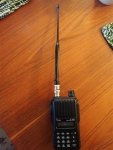Josh KI6NAZ conducted a semi-scientific field test of various handheld radio antennas. Comparison chart at 7:56 into the video. What I don't quite understand is why the reported received signal strength ("power") and reported SNR don't track. Seems to me that the higher the received signal strength, the better the SNR. How could two antennas of same received signal strength have different SNRs?
You are using an out of date browser. It may not display this or other websites correctly.
You should upgrade or use an alternative browser.
You should upgrade or use an alternative browser.
Field comparison of handheld radio antennas
- Thread starter AK9R
- Start date
- Status
- Not open for further replies.
vagrant
ker-muhj-uhn
As he is transmitting at different times, could intermittent RFI affect those numbers? Paging signals and or nearby public/private repeaters are intermittent. If he did more sampling say at least three times each session vs. the single in the video, over two or three days...Yes, that is a lot of sampling, but more numbers help.
I have four 152 MHz paging towers that simulcast and cause terrible RFI. I use two PAR paging filters inline that help with my main RX antenna. Even my noise floor up on UHF will shift when they transmit without the filters inline. I also use a paging filter with my scanner in the vehicle and my VHF/UHF mobiles at home and in the vehicle. RFI and intermod were eliminated. I actually have six of those 152 filters in one form or another in use and that cost adds up quick, but it is worth it. I actually have six various filters inline on my main RX antenna to squish the RFI problems. The cost is just under $500 for the filters alone. That is because I am using a discone and cover a wide range of frequencies. For 225-400 MHz Mil Air I use a Mil Air antenna with a single specific filter for that range. As my coverage range is less for that, my filter needs are less.
Antennas and coaxial cable are essential, but without the filters for FM broadcast and or whatever else, one may suffer quite a bit and perceive their equipment is poor or faulty. Of course everyone's location is different.
I have four 152 MHz paging towers that simulcast and cause terrible RFI. I use two PAR paging filters inline that help with my main RX antenna. Even my noise floor up on UHF will shift when they transmit without the filters inline. I also use a paging filter with my scanner in the vehicle and my VHF/UHF mobiles at home and in the vehicle. RFI and intermod were eliminated. I actually have six of those 152 filters in one form or another in use and that cost adds up quick, but it is worth it. I actually have six various filters inline on my main RX antenna to squish the RFI problems. The cost is just under $500 for the filters alone. That is because I am using a discone and cover a wide range of frequencies. For 225-400 MHz Mil Air I use a Mil Air antenna with a single specific filter for that range. As my coverage range is less for that, my filter needs are less.
Antennas and coaxial cable are essential, but without the filters for FM broadcast and or whatever else, one may suffer quite a bit and perceive their equipment is poor or faulty. Of course everyone's location is different.
I'm not sure if this analogy applies, but a tuned loop antenna at HF with a very narrow bandwidth would typically have a very low signal strength, but a great signal to noise ratio.Josh KI6NAZ conducted a semi-scientific field test of various handheld radio antennas. Comparison chart at 7:56 into the video. What I don't quite understand is why the reported received signal strength ("power") and reported SNR don't track. Seems to me that the higher the received signal strength, the better the SNR. How could two antennas of same received signal strength have different SNRs?
Thanks
Joel
mmckenna
I ♥ Ø
It sort of defeats the purpose of having a small, pocket-size radio, with an antenna 10x the size of the radio.
Just how critical does a transmission signal be to have to go to those extremes?
I've never really paid attention to this before, but at IWCE, Hascall-Denke has some foldable blade VHF antennas specifically marketed to the rail industry and designed to work with the Icom/Kenwood NXDN radios.
There's been another thread on here (or maybe another site) talking about railroad radio system coverage issues. Seems like if things depend on an unwieldy antenna to work, there's some serious design issues with their radio systems.

(1Y46150B) MPMP160-161AC - Hascall-Denke
 www.hascall-denke.com
www.hascall-denke.com
vagrant
ker-muhj-uhn
How dare you use logic and hurt their salesIt sort of defeats the purpose of having a small, pocket-size radio, with an antenna 10x the size of the radio.
I just took a look at that Hascall-Denke and they advise in the marketing material that it, "Operates in folded position". I am not saying it wouldn't, but that's not nice.
Anyways, the best (reasonable) handheld VHF/UHF combo antenna I have is the Moto one on my APX7000xe. It is a little over 8 inches and handles the GPS as well. I think it is the PMAT4001. If I didn't have the 7000, I would have that antenna on my XTS5000 VHF and UHF radios, but they sit in an XTVA all day with their monoband version, connected to an external.
It sort of defeats the purpose of having a small, pocket-size radio, with an antenna 10x the size of the radio.
Just how critical does a transmission signal be to have to go to those extremes?
Just taking a wild guess here.
It's possible that it improves flexibility, at least in the purchasers or users mind. Like having a single PRC-77 manpack radio that can be used for very small unit communications (in the past), with a relatively small flexible whip... or it can be hooked up to a military-half-rhombic to substantially increase its range (or two of the radios could be hooked together with adapter cables to make a repeater).
Thanks
Joel
vagrant
ker-muhj-uhn
Ha! I actually have one of those Abbree 40+ inch antennas. I did not buy it, so I forgot about it as it was sitting behind other stuff and I happened to see it just now. A fellow club ham came up to my table at a hamfest in November and said, "Here you go". I guess he could not sell it.
Okay, I just swept it and it is under 1.5 on 146. It's actually very passible to work on 1.25 meters as well. At 446 MHz the SWR was like 2:1. Too bad it does not fit into the antenna well of my APX. I could pop it in there and be the king of all ding dongs.
Okay, I just swept it and it is under 1.5 on 146. It's actually very passible to work on 1.25 meters as well. At 446 MHz the SWR was like 2:1. Too bad it does not fit into the antenna well of my APX. I could pop it in there and be the king of all ding dongs.
k6cpo
Member
I bought into the hype about the longer antennas when I was first starting out. Until I almost jabbed myself in the eye with one... Now I use antennas about the size of the originals, but with more flexibility. I never notice an appreciable signal gain, either transmitting or receiving wth the longer ones anyway. Now they just take up space in a drawer.
I bought into the hype about the longer antennas when I was first starting out. Until I almost jabbed myself in the eye with one...
During desert shield and storm, photos came out of people using H.T.s with what looked like a ball of electrical tape on the end of H.T.s antennas. Originally it was thought that it was some special way of improving the antennas performance, then it was decided that it was to not poke themselves in the eyes.
Later I figured out (from experience) that the end caps of MT 500s were a hard brittle plastic, and people would also tend to bite/chew on them (absentmindedly), although we never put electrical tape on them until it got to the point where the stiff wire helix was exposed.
Thanks
Joel
KB2GOM
Active Member
My best-performing 2 meter HT antenna is this one:

And I don't know what it is! It's about nine inches long, has a coil at the base, and has a green tip. It was given to me by a client (a metallurgical test equipment company) who had "a friend in the radio business."
Head-to-head, it out performs Diamond 77, and -- here's the weird part, which I really don't understand and cannot explain -- delivers better audio, according to some of my test "victims."
If anyone can ID this antenna, I would be glad to know.
Here it is, mounted on my Icom V80:


And I don't know what it is! It's about nine inches long, has a coil at the base, and has a green tip. It was given to me by a client (a metallurgical test equipment company) who had "a friend in the radio business."
Head-to-head, it out performs Diamond 77, and -- here's the weird part, which I really don't understand and cannot explain -- delivers better audio, according to some of my test "victims."
If anyone can ID this antenna, I would be glad to know.
Here it is, mounted on my Icom V80:

Could be a Larsen Kulduckie (Amazon.com).
KB2GOM
Active Member
Could be a Larsen Kulduckie (Amazon.com).
That looks right. Works very well.
+1 on the Larsen. I've had one for years. Works well and is well made.
mmckenna
I ♥ Ø
Yeah, I had one of those Larsen Kuldukies for years and it was a good antenna.
- Status
- Not open for further replies.
Similar threads
- Replies
- 7
- Views
- 1K
- Replies
- 44
- Views
- 4K

